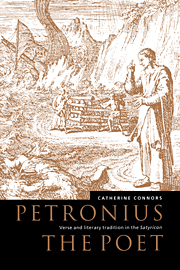Book contents
- Frontmatter
- Contents
- Prefatory note
- Acknowledgements
- List of abbreviations
- Introduction
- 1 Refashioning the epic past
- 2 In the frame: context and continuity in the short poems
- 3 Troy retaken: repetition and re-enactment in the Troiae Halosis
- 4 The Bellum Civile
- Epilogue
- Bibliography
- Index of passages discussed
- Index of subjects
1 - Refashioning the epic past
Published online by Cambridge University Press: 28 October 2009
- Frontmatter
- Contents
- Prefatory note
- Acknowledgements
- List of abbreviations
- Introduction
- 1 Refashioning the epic past
- 2 In the frame: context and continuity in the short poems
- 3 Troy retaken: repetition and re-enactment in the Troiae Halosis
- 4 The Bellum Civile
- Epilogue
- Bibliography
- Index of passages discussed
- Index of subjects
Summary
During his banquet, Trimalchio tells a peculiar story about the origins of Corinthian bronze (50.5–6):
cum Ilium captum est, Hannibal, homo vafer et magnus stelio, omnes statuas aeneas et aureas et argenteas in unum rogum congessit et eas incendit; factae sunt in unum aera miscellanea, ita ex hac massa fabri sustulerunt et fecerunt catilla et paropsides 〈et〉 statuncula. sic Corinthea nata sunt, ex omnibus in unum, nee hoc nee illud.
When Troy was captured, Hannibal, a crafty man and a great slippery character, piled up all of the statues, bronze, gold, and silver, into one heap and set them alight; they were melded together into a bronze mixture. So craftsmen took pieces out of this lump and made small bowls and serving dishes and statuettes. Corinthian bronzes were produced this way from metals all mixed together, neither one kind nor another.
Trimalchio's tale operates against a background of Roman connoisseurship of authentic Corinthian bronze. So, for example, Velleius Paterculus (1.13) uses Corinthian bronze as an index of the difference between two conquering generals, Scipio Aemilianus, whom he describes as cultured (elegans), and Mummius, whom he calls uncultured (rudis): Mummius was so uncultured that when he brought back bronzes from Corinth he had his shippers promise that if the bronzes were lost in transit they would replace them with new ones.
- Type
- Chapter
- Information
- Petronius the PoetVerse and Literary Tradition in the Satyricon, pp. 20 - 49Publisher: Cambridge University PressPrint publication year: 1998



